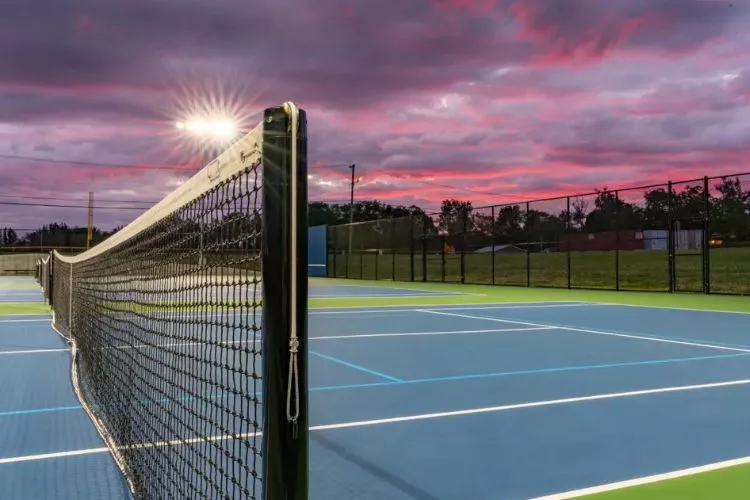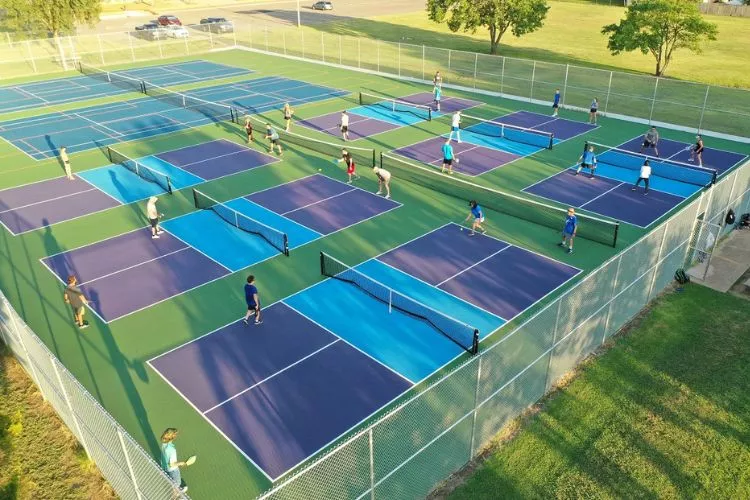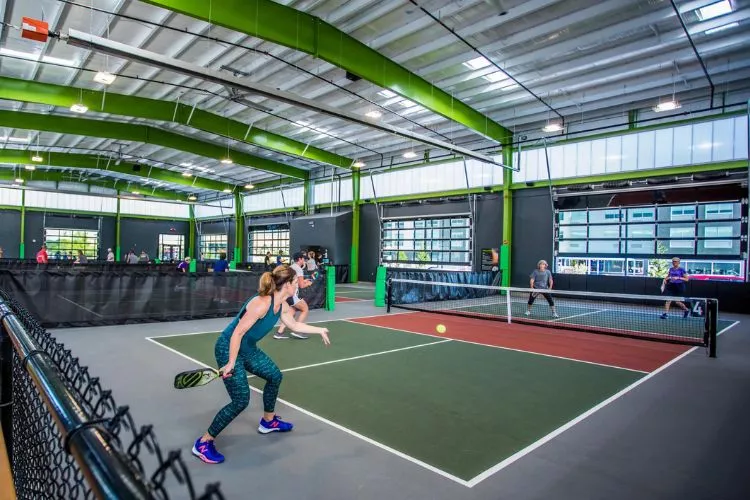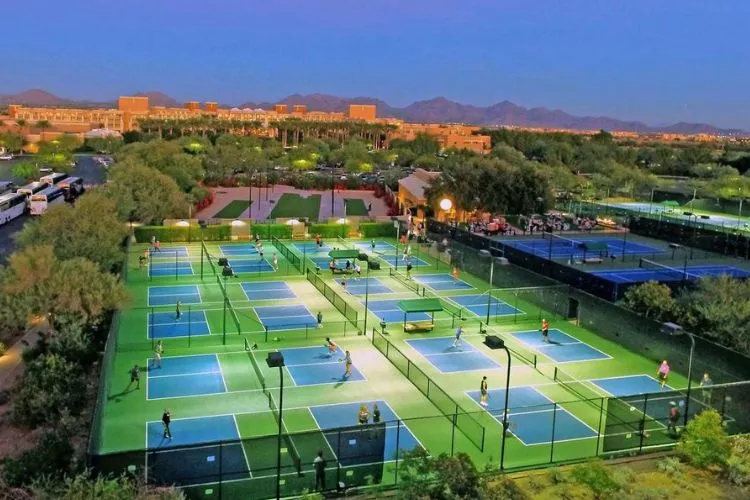Pickleball has gained immense popularity in recent years, attracting players of all ages. To fully enjoy this exciting sport, choosing the right type of pickleball court is crucial.
But, the issue currently we have different types of pickleball courts, and it’s not an easy task to pick the one that suits your need.
With various options available for indoor and outdoor play, it’s essential to understand the different surfaces and their pros and cons.

2 Best types of pickleball courts
In this comprehensive guide, we will explore the various types of pickleball courts and help you make an informed decision for your next game.
Outdoor Pickleball Courts
Outdoor pickleball courts are commonly found in parks, community centers, and recreational spaces. Let’s dive into the different types of outdoor pickleball courts and discuss their features:

Asphalt Courts: Asphalt courts are a popular choice due to their affordability and durability. A smooth and flat surface provides consistent ball bounce, making it ideal for players of all skill levels.
However, asphalt surfaces may require regular maintenance, and temperature fluctuations can affect playing conditions.
Concrete Courts: Concrete courts offer excellent durability and require minimal maintenance. The surface is typically smooth, allowing for consistent ball bounce.
Although concrete courts may be more expensive than asphalt, they provide a long-lasting playing surface that can withstand harsh weather conditions.
Poured-in-Place Courts: Poured-in-place courts feature a cushioned surface made of rubber or acrylic layered over a concrete base. This type of court offers shock absorption, reducing the risk of injuries.
Poured-in-place courts provide excellent traction, enhancing player performance. However, they can be more expensive to install and require regular maintenance.
Modular Tile Courts: Modular tile courts consist of interlocking plastic tiles placed over a solid base. This type of court offers various benefits, including quick installation, excellent drainage, and easy maintenance.
The shock-absorbing properties of modular tile courts provide added comfort during play. However, the cost of these courts can be higher compared to other options.
Indoor Pickleball Courts
Indoor pickleball courts are commonly found in sports complexes, gyms, and recreation centers. Let’s explore the different types of indoor pickleball courts and their features:

Wood Courts: Wood courts offer a traditional playing surface with excellent ball control and consistent bounce.
The resilient nature of wood reduces player fatigue and joint stress. However, they need regular maintenance to preserve their smoothness and prevent warping or splintering.
Synthetic Courts: Synthetic courts provide a durable and low-maintenance playing surface. These courts are often made of materials like polypropylene or acrylic, offering consistent ball bounce and good grip.
Synthetic surfaces typically require less maintenance than wood and are resistant to weather conditions.
Carpet Courts: Carpet courts consist of a cushioned subfloor covered with a high-quality carpet. This type of court provides a comfortable playing surface, reducing strain on joints.
Carpet courts often offer moderate ball speed, making them suitable for players seeking controlled shots. However, carpet courts may require occasional replacement or repairs due to wear and tear.
What is the best floor for pickleball?
When it comes to choosing the best floor for pickleball, it depends on several factors such as location, facility type, and personal preferences. In general, the most popular floors for pickleball courts are made of concrete, asphalt, and modular tile.
Concrete courts are durable, long-lasting, and require minimal maintenance. They provide consistent ball bounce and an excellent surface for players of all skill levels. Asphalt courts are also popular due to their affordability and longevity.
They offer excellent traction and smoothness, resulting in consistent ball play. Modular tile courts are a newer option that has been gaining popularity in recent years.
These interlocking plastic tiles provide excellent drainage, easy maintenance, and a consistent ball play. They provide excellent shock absorption, minimizing the risk of injury.
Indoor pickleball courts often have surfaces like wood, synthetic, and carpet. Wood offers a traditional playing surface that provides excellent ball control and consistent bounce. Synthetic surfaces offer durability and low maintenance.
Carpet surfaces reduce joint stress and provide excellent ball speed control for players.
Ultimately, the best floor for pickleball depends on your specific needs, budget, and local environment. It’s always a good idea to consult with a professional or experienced player to determine the best surface for your unique situation.
How thick should a pickleball court be?
According to the USA Pickleball Association, there is no specific thickness requirement for pickleball courts. However, it is recommended that court surfaces should be firm, flat, and level, with good drainage.

The most popular surfaces for outdoor courts are concrete, asphalt, and modular tile. Concrete and asphalt surfaces are typically at least four inches thick and can be layered with additional coatings for optimal play.
Modular tile courts come in various thicknesses and are easy to install. Indoor pickleball courts typically have hardwood or synthetic surfaces, which maintain their playing characteristics over time.
What is the cheapest way to make a pickleball court?
The cheapest way to make a pickleball court, asphalt and concrete are the most popular surfaces because they are durable and long-lasting.
It’s important to note that the cost of constructing a pickleball court can vary significantly depending on the location, materials, and labor.
In general, using an existing tennis court and repurposing it for pickleball can be more cost-effective than building a new court from scratch. However, it’s crucial to ensure that the court is proportionally correct to avoid potential safety issues.
Frequently Asked Questions (FAQs)
What size are pickleball courts?
Pickleball courts are typically 20 feet wide and 44 feet long for doubles play. However, for singles play, the court size can be reduced to 20 feet wide and 22 feet long.
Can outdoor pickleball courts be used for indoor play?
In some cases, outdoor courts can be transitioned for indoor play by adding a removable cover or enclosing the area. However, it’s important to consider factors like ventilation, lighting, and surface compatibility.
How much does it cost to build a pickleball court?
The cost of building a pickleball court varies depending on factors such as the type of surface, location, and amenities. On average, an outdoor court can cost between $10,000 and $30,000, while an indoor court may range from $20,000 to $50,000 or more.
Conclusion:
Choosing the right pickleball court is essential for an enjoyable and competitive game.
Whether you opt for an outdoor court like asphalt or concrete or prefer the comfort of indoor surfaces like wood or synthetic, understanding the features and considerations of each type will help you make an informed decision.
Consider your playing preferences, maintenance needs, and budget to find the perfect pickleball court that suits your needs.

Pickleball’s more than a game to me—it’s a passion. I write, sharing its highs and lows, the thrills and the lessons. Some tales might draw you to the court, while others give a hint of the game’s magic. So, curious about my journey? Ready to dive deep into the world of pickleball with me? Let’s go.
